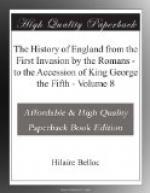Both Antrim and Montrose professed themselves the personal enemies of the earl of Argyle, appointed by the Scottish estates lieutenant of the kingdom; and they speedily arranged a plan, which possessed the double merit of combining the interest of the king with the gratification of private revenge. Having obtained the royal commission,[1] Antrim proceeded to Ulster, raised eleven or fifteen hundred men among his dependants, and despatched them to the opposite coast of Scotland under the command of his kinsman Alaster Macdonald, surnamed Colkitto.[2] They landed at Knoydart: the destruction of their ships in Loch Eishord, by a hostile fleet, deprived them of the means of returning to Ireland; and Argyle with a superior force cautiously watched their motions.[a] From the Scottish royalists they received no aid; yet Macdonald marched as far as Badenoch, inflicting severe injuries on the Covenanters, but exposed to destruction from the increasing multitude of his foes. In the mean time, Montrose, with the rank of lieutenant-general, had unfurled the royal standard at Dumfries;[b] but with so little success, that he hastily retraced his steps to Carlisle, where by several daring actions he rendered such services to the royal cause, that he received the title of marquess from the gratitude of the king. But the fatal battle of Marston Moor induced him to turn his thoughts once more towards Scotland;[c] and having ordered his followers to proceed to Oxford, on
[Footnote 1: He was authorized to treat with the confederate Catholics for ten thousand men; if their demands were too high, to raise as many men as he could and send them to the king; to procure the loan of two thousand men to be landed in Scotland; and to offer Monroe, the Scottish commander, the rank of earl and a pension of two thousand pounds per annum, if with his army he would join the royalists. Jan. 20, 1644.—Clarendon Papers, ii. 165.]
[Footnote 2: MacColl Keitache, son of Coll, the left-handed.]
[Sidenote a: A.D. 1644. July 8.] [Sidenote b: A.D. 1644. April 13.] [Sidenote c: A.D. 1644. May 6.]
the third day he silently withdrew with only two companions, and soon afterwards reached in the disguise of a groom the foot of the Grampian Hills. There he received intelligence of the proceedings of Macdonald, and appointed to join him in Athole.[a] At the castle of Blair, which had surrendered to the strangers, the two chieftains met: Montrose assumed the command, published the royal commission, and called on the neighbouring clans to join the standard of their sovereign. The Scots, who had scorned to serve under a foreigner, cheerfully obeyed, and to the astonishment of the Covenanters an army appeared to rise out of the earth in a quarter the most remote from danger; but it was an army better adapted to the purpose of predatory invasion than of permanent warfare. Occasionally it swelled to the amount of several thousands: as often it dwindled to the original band of Irishmen under Macdonald. These, having no other resource than their courage, faithfully clung to their gallant commander in all the vicissitudes of his fortune; the Highlanders, that they might secure their plunder, frequently left him to flee before the superior multitude of his foes.




